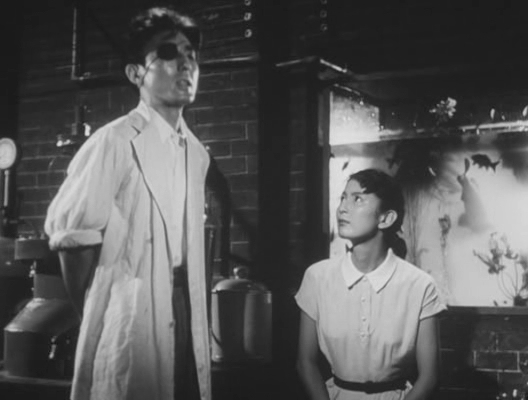
A lot as been said about 1954's Godzilla (ゴジラ) as an allegory for postwar Japan and the world political environment surrounding the atom bomb. It clearly does deal with these issues, and in concept rather interestingly, but in deployment rather awkwardly. For the psychological effects on Japan of World War II, I could point out a lot of superior films--Record of a Living Being, Floating Clouds, Stray Dog, Drunken Angel, and many others. As a monster/disaster film, putting aside the allegory, Godzilla is mostly unsatisfying, inferior, as Roger Ebert observed in his review, to the much older King Kong.
The movie begins with the mysterious effects of the mostly unseen monster--ships lost at sea, strange tidal conditions. When Godzilla does set foot on land, we don't see him clearly, which is wise, but somehow the shots of people panicking and buildings crumbling don't quite achieve the sense of menace I might have thought they would.

Takashi Shimura has a role in the movie as a top scientific advisor to the government. I guess Takashi Shimura is to Godzilla as Ian Holm was to The Day After To-morrow, though Godzilla is at least a better movie than that waste of time. Both films are filled with blatant scientific inaccuracies and senseless behaviour on the parts of the protagonists, but there's a certain poetry to these flaws in Godzilla.
Shimura was the biggest star in the movie, having been playing leading roles in popular films for over a decade at this point, but he's given the somewhat insurmountable task of making us sympathise with his desire to keep Godzilla alive for scientific purposes while the monster is rampaging and killing scores of defenceless people. When the weight of carnage gets too much for even the filmmakers to comfortably continue with Shimura's initial motivation, the character's reduced to being just another shocked bystander.
Foremost in the plot are Emiko, the daughter of Shimura's character, and the two men in love with her, Ogata and Serizawa.

Serizawa's a sort of mad scientist with a conscience. He's been locked in his laboratory wearing an eye patch for years, developing a device that when dropped into a fish tank splits all the oxygen atoms in the water resulting in the live fish being instantly turned into floating fish skeletons. He's been keeping this discovery a secret while he tries to think of a positive application for it, but he reveals it to Emiko under the condition that she tell no-one.
After seeing the horribly wounded victims of Godzilla at a hospital, Emiko painfully decides to break her promise and tell Ogata about Serizawa's device because it may be the only way to stop Godzilla. Emiko can't simply go to Serizawa herself to convince him to use the device because I guess that's a man's job, and she can't tell her father, the chief scientific advisor to the government, because telling the Serizawa's rival for her affections gives us the opportunity to tie a pissing contest to the argument over whether or not to use a weapon of mass destruction.
But Serizawa's fierce reluctance to use the device is interesting when one compares it with the relative eagerness with which the U.S. developed and deployed the atomic bomb. My favourite part of the movie was the climax where Ogata and Serizawa walk slowly on the ocean floor with the device in search of Godzilla. There's no logical reason why the device needed to be deployed by hand, but one appreciates how Serizawa regards the situation--his desire to kill himself in the process not only to destroy all knowledge of how the device was constructed but also just as a reflection of what using such a weapon means. It's not in any sense a good thing, just a horrible necessity. Akira Ifukube's beautiful, sombre score emphasises this and this scene has my favourite shot of the monster, walking slowly, obscured by underwater haze.

As the victim of the weapon, one could see Godzilla in a way as a metaphor for the Japanese people, or rather the dark mirror self image that develops from the mind of the abused, who looks for sense in senseless destruction by seeing himself as monstrous.

No comments:
Post a Comment